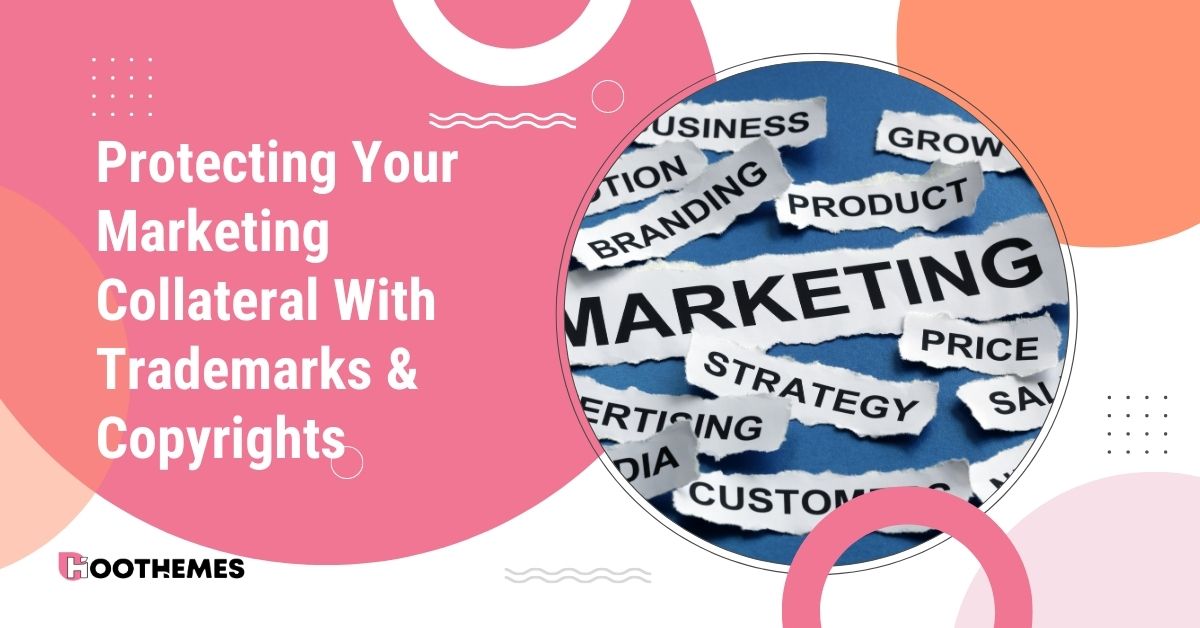In today’s digital world, millions of marketing campaigns run at every given time, with all the advertisers competing for the same audience. That’s why marketing collateral is getting more crucial.
So when running a serious marketing campaign, you must make it stand out by conducting market research, grabbing your audiences’ attention, and creating a connection between the ads in your brand.
One way to make this possible is by protecting your marketing collateral with trademarks and copyrights. This guide delves into protecting your marketing collateral with trademarks and copyright and is a good read if you are running a marketing campaign.
What Is Marketing Collateral?
It’s the materials you use in your marketing strategy. These materials include video files, social media posts, infographics, brochures, white papers, case studies, audio files, etc.
These materials are like the window through which your audience learns who you are and what you stand for as a company. When used correctly, marketing collateral can create brand awareness, lead generation, and closing deals.
Creating a message that your audience can relate to takes time and money. So, you want to ensure that its value will be worth the investment and that another entity cannot use the same in marketing, and that’s where protecting your marketing collateral with copyright and trademarks comes in.
Benefits of Protecting Your Marketing Collateral with Copyright and Trademark Rights
Let’s take a closer look now, shall we? Here are the benefits of protecting your marketing collateral:
#1 Exclusive Use
Registering your marketing collateral gives you verifiable legal ownership of your materials. Under IP laws, the legal owner of an intellectual property has exclusive rights to their use. So, any entity that uses the same without express authorization from the owner will infringe on the rights of the IP right holder.
It also gives you the legal authority to stop and sue them for monetary damages resulting from the infringement. This exclusivity lets you control how and where your marketing collateral will be used.
With time the materials become synonymous with your brand, and your audience will always think about them whenever they come across them.
#2 Brand Reputation
A positive brand reputation is extremely critical for a business’s success. But you can only fully control your brand’s reputation if you control everything concerning your brand’s products and messaging.
So, suppose you do not control all products bearing your brand name in the market. In that case, you cannot talk about controlling your brand reputation because the products that are out of your control but may be mistaken for your products will hurt your brand reputation. The same goes for your marketing collateral.
Matching your messaging and brand identifiers with quality products effectively creates a positive brand image. When used by other entities to market substandard products or products that don’t represent what you stand for as a company, your brand reputation takes a hit.
By registering your marketing collateral, you are assured that nobody can use your materials for marketing their products, ensuring control over every brand-related content and product that gets out there.
Registering Your Marketing Collateral
The Canadian Intellectual Property Office is Canada’s constitutionally-mandated agency for IP rights registration. The agency offers three options for registration; in-person, online, and through mail.
The processes for registering trademarks and copyright differ. For trademark registration, you must start by conducting a trademark search. You can read a guide by HeerLaw to better understand everything about conducting Canadian trademark searches before filing for registration.
Copyright protections apply by default, meaning you can enforce your copyrights without registering them. But registering them makes enforcement much easier.
FAQs About Marketing Collateral
Here are some frequently asked questions that can help you better understand the subject of marketing collateral:
Q1. What Is the Difference Between Trademarks and Copyrights?
Trademarks primarily protect brand names, logos, slogans, and other distinctive elements that identify the source of goods or services. They provide exclusive rights to use those identifiers in the marketplace.
On the other hand, copyrights protect original creative works such as videos, graphics, text, and music, giving the owner exclusive rights to reproduce, distribute, and display the work.
Q2. How Do You Create Marketing Collateral?
Creating effective marketing collateral involves several steps to ensure that your materials align with your brand message and resonate with your target audience. Here’s a general process for creating marketing collateral:
- Define your objectives: Determine the purpose and goals of your marketing collateral. Are you aiming to increase brand awareness, generate leads, or drive sales? Clearly outline what you want to achieve with your materials.
- Understand your target audience: Research and analyze your target audience to gain insights into their preferences, needs, and pain points. This understanding will help you tailor your collateral to resonate with them effectively.
- Craft compelling content: Develop engaging and persuasive content that communicates your brand message and offers value to your audience. Use persuasive language, storytelling techniques, and compelling visuals to capture attention and evoke the desired response.
- Design visually appealing materials: Create visually appealing designs that align with your brand identity and capture the attention of your audience. Use consistent branding elements, such as colors, fonts, and logos, to maintain brand consistency across all collateral.
- Choose the right format: Select the appropriate format for your marketing collateral based on your objectives and target audience. It can include brochures, flyers, social media posts, videos, infographics, case studies, white papers, or a combination of different formats.
- Ensure accessibility: Optimize your collateral for accessibility by considering factors such as readability, color contrast, and alternative text for images. This ensures that your materials can be easily consumed by a diverse audience.
- Test and iterate: Before finalizing your marketing collateral, gather feedback from colleagues, stakeholders, or a sample audience. Incorporate their input and make necessary revisions to improve the effectiveness of your materials.
- Distribute and promote: Once your marketing collateral is ready, strategically distribute it through appropriate channels to reach your target audience. Leverage various platforms such as websites, social media, email campaigns, events, and print distribution to maximize exposure.
Final Words
As a marketer, you know the importance of standing out and being consistent in your marketing messaging. Once you get your messaging right, you want to ensure that only you have the right to use your marketing materials by registering your marketing collateral as trademarks and for copyright protection.









